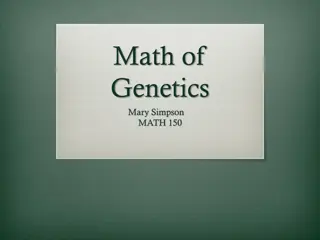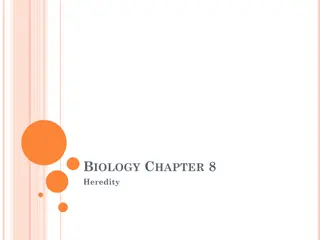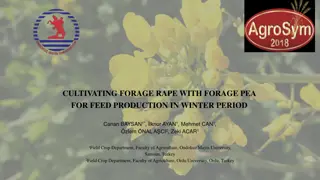The Legacy of Gregor Mendel: Father of Genetics and Pea Plant Experiments
Gregor Mendel, a monk from the 1800s, conducted groundbreaking experiments with pea plants to study inheritance patterns. By meticulously observing traits like seed color and pod shape, Mendel discovered the principles of heredity and laid the foundation for modern genetics. His work on dominant and recessive traits revolutionized our understanding of how characteristics are passed down from parents to offspring.
Download Presentation

Please find below an Image/Link to download the presentation.
The content on the website is provided AS IS for your information and personal use only. It may not be sold, licensed, or shared on other websites without obtaining consent from the author. Download presentation by click this link. If you encounter any issues during the download, it is possible that the publisher has removed the file from their server.
E N D
Presentation Transcript
Who was Gregor Mendel? (And why was his work so important?)
Gregor Mendel Gregor Mendel was a monk who lived in the 1800s
Mendels Mind Wandered Mendel wondered how the same species of plants could have different characteristics Characteristic is a trait that makes the plant (and you) look a certain way
Mendel began to think Mendel wondered about the Characteristics that appeared with each generation He wondered if they were heritable features Heritable means they are inherited (passed down) from parents to children Some traits appeared more often with the same parent plants Mendel wondered why
Pea Plants Mendel performed an experiment and chose pea plants to use He chose pea plants because he could identify seven pairs of contrasting traits found among typical garden peas: Seed color (yellow or green) Seed shape (smooth or wrinkled) Pod color (yellow or green) Pod shape (inflated or pinched) Flower color (purple or white) Flower position (middle or end) Stem height (tall or short)
Either or. One or the other Easy to see AND collect data!
Watching the plants grow For two years, Mendel grew different varieties of peas to make sure that their offspring were always the same This meant that the plants he used were purebred Purebred means an organism always produces the same traits in its offspring
Think about purebred dogs When you purchase a purebred dog, you receive a record of their family tree so you know who their parents and grandparents and great grandparents were! Proof that the dog is purebred.
Patience is a virtue After recording his observations over a couple of years, Mendel decided to breed different varieties together to make hybrids Hybrid means it s a mix - a cross - of different traits (Think Hybrid cars!) He made these hybrids by cross-pollinating plants with different characteristics Cross-pollinating means mating (crossing) two different plants of the same species White flower x Purple flower Smooth pea x Wrinkled pea
Cross-pollinating (making hybrids) Mendel brushed the pollen off yellow pea plants and put it on green pea plants He did the same for plants with each of the seven pairs of traits He then grew generation after generation of hybrids and tracked the appearance of the different traits
His Findings Crossing Hybrids gives a 3 to 1 ratio of traits in offspring!
Crossing Characteristics Mendel crossed many different traits and carefully recorded the traits of the offspring He determined that each parent supplies one unit or factor for each different trait Somehow Some traits seemed to disappear in the first generation but reappear later
Recessive and Dominant The traits that disappeared in the first generation of hybrids he called Recessive. He called those that always appear, Dominant. In later generations the recessive traits reappeared in a predictable pattern. For example, later generations of plants had one green pea for every three yellow peas. The same ratio appeared for all seven pairs of traits.
Pea Soup Anyone? Mendel grew an estimated 28,000 pea plants over eight years. He recorded the traits of parent generations (P) as well as the traits of the first generation (F1) (F1) is the First Filial generation: the first offspring to be born Can you guess what the second generation was listed as? _____________
What Mendel Discovered Mendel discovered that traits are inherited And it occurs in a consistent pattern Mendel used math to figure out what was going on in the cell and how the factors (traits) would be passed on. See????? Math IS useful!!!!
The Father of Genetics He published his results, observations and conclusions These are now known as Mendel s Laws Mendel's laws of heredity work with other organisms as well They form the basis of modern genetics Even though Mendel knew nothing about genes and DNA, we call him the Father of Genetics
Now called Genetics Mendel used the terms unit , factor and element to describe how traits are inherited (passed) from parents to offspring Today, we call these units GENES (DNA) Genes are found on our chromosomes (in the nucleus of our cells) and are made up of DNA (which is made of nucleotides!)
What are Genes, Anyway? Genes are the basic unit of heredity They are a sequence of DNA that causes a certain characteristic to appear in an organism Genetics is the science of genes, traits and heredity Genetics is the study of how traits are inherited (through genes) from one generation to another
The Punnett Square Mendel found out that every trait is controlled by two elements (genes) One from one parent and one from the other parent Now, the Punnett Square is used to show how different traits are passed from one generation to the next This is called Probability The chance that a given event will occur
Predictable Ratios Mendel repeated his experiments over and over and the F2 generation always had a 3:1 ratio of yellow to green or round to wrinkly Mendel then crossed plants that differed in more than one trait: round, yellow peas with wrinkled, green one, or tall, violet- flowered plants with short, white-flowered ones These traits appeared in predictable ratios, too
Dominant & Recessive Mendel determined that, in order to show-up, a Dominant trait needs only one trait unit from one of the parents A dominant trait can cover up (mask) a recessive trait Dominant is stronger, more powerful The Recessive trait needs two units , from both parents, in order to show up in the next generation Recessive is weak , possessing little power/influence
Mendels Laws of Inheritance Mendel came up with these important conclusions known as Mendel s Laws: The Law of Dominance states that some unit characters can mask the expression of others. The Law of Segregation states that each unit character separates into a different sex cell. The Law of Independent Assortment states that genes segregate (separate) according to chance.
The Vocabulary of Genetics The genetic make-up of an organism is called its genotype It is the type of genes found in the cell The appearance of the organism that is determined by its genotype is called its phenotype It is how the organism looks (appears) on the outside
Homologous Pairs When making a new organism, one gene from the mother matches up with a similar gene from the father These genes are called homologous pairs Homologous means similar (in length, size, genetic make up, etc ) The homologous genes are found on chromosomes so, if homologous genes pair up, they create homologous chromosomes!
Genes Vs. Alleles A gene is a section of DNA which codes for a certain characteristic, such as height. Genes, however, can have variations and this is where alleles come in Height can be either tall or short Alleles are different versions of a gene. For example, a tall allele or a short allele. They are the different sequences of DNA that determine a single characteristic (height). They occur in pairs (one from one parent, one from the other) and can be classified as recessive or dominant.
More Vocab! Homozygous means that the two alleles (genes) for an organism are exactly the same (TT or tt). Also known as Purebred Heterozygous means that the two alleles for an organism are different (Tt). Also known as Hybrid
Heredity Heredity is the passing of traits from one generation to another . Inherited traits are passed (genetically), from the parent generation to the offspring
How do Geneticists figure it out? Geneticists use letters to represent alleles. The same letter is used to indicate both alleles. A capital letter = a Dominant trait A lowercase letter = a Recessive trait Examples: Flower color: P= purple, p= white Seed color: Y= yellow, y = green Seed shape: W = wrinkled, w = round
In humans. Widow's peak: W = widow's peak, w = continuous hairline Freckles: F = freckles, f = no freckles Earlobes: E = unattached, e = attached Thumbs: H = hitch-hiker, h = non-hitch-hiker Cleft chin: C = cleft chin, c = no cleft chin Hair on Fingers: F = hair, f = no hair Spock Fingers: S = spock yes, s = spock no Handedness: R = right handed, r = left handed
Genes & Mutations Each gene carries a separate piece of information DNA codes for all genes Changes in the sequence of the DNA molecule (and therefore the gene) are called mutations A mutation may change the manner in which a trait is expressed by an organism. So, a mutation in the genotype, changes thephenotype Remember that not all mutations are bad!























